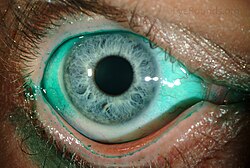Optical health
Optometry & ophthalmology are the two secondary specialties.
Disorder categories
1. Epilepsy
Digital addict can lead to flashing lights and quickly changing colours that lead to epilepsy.
2. Seizure
Digital addict can also lead to grainy pixels with random colours in screen that lead to seizures.
3. Dry eye syndrome

Dry eye disease (DED), also known as keratoconjunctivitis sicca, is the condition of having dry eyes. [9] The term dry eye syndrome was formerly used, but is now avoided following advances that have established it as a distinct disease entity. [10]
Symptoms of dry eye include dryness in the eye, irritation, redness, discharge, blurred vision, and easily fatigued eyes. Symptoms range from mild and occasional to severe and continuous. [11] Dry eye disease can lead to blurred vision, instability of the tear film, increased risk of damage to the ocular surface such as scarring of the cornea, and changes in the eye including the neurosensory system. [9] [12]
Dry eye occurs when either the eye does not produce enough tears or when the tears evaporate too quickly. [9] This can be caused by age, contact lens use, meibomian gland dysfunction, [13] pregnancy, Sjögren syndrome, vitamin A deficiency, omega-3 fatty acid deficiency, LASIK surgery, and certain medications such as antihistamines, some blood pressure medication, hormone replacement therapy, and antidepressants. [9] [11] [14] Chronic conjunctivitis such as from tobacco smoke exposure or infection may also lead to the condition. [9] Diagnosis is mostly based on the symptoms, though several other tests may be used. [15] Dry eye disease occasionally makes wearing contact lenses impossible. [9]
Treatment depends on the underlying cause. Artificial tears are usually the first line of treatment. Wrap-around glasses that fit close to the face may decrease tear evaporation. [16] Looking carefully at the medications a person is taking and, if safe, altering the medications, may also improve symptoms if these medications are the cause. Some topical medications, or eye drops, may be suggested to help treat the condition. The immunosuppressant cyclosporine (ciclosporin) may be recommended to increase tear production and, for short-term use, topical corticosteroid medications are also sometimes helpful to reduce inflammation. [12] Another treatment that is sometimes suggested is lacrimal plugs that prevent tears from draining from the surface of the eye.
Dry eye syndrome is a common eye disease. [11] It affects 5–34% of people to some degree depending on the population looked at. [17] Among older people it affects up to 70%. [18] In China it affects about 17% of people. [19] The phrase "keratoconjunctivitis sicca" means "dryness of the cornea and conjunctiva" in Latin. [20]4. The Three Twenties (20-20-20) Rule
The 20-20-20 rule is a simple guideline to prevent digital eye strain from prolonged screen time: Every 20 minutes, look at something 20 feet away for at least 20 seconds. This break allows the eye muscles to relax by shifting focus from a nearby screen to a distant object, which helps reduce symptoms of digital eye strain such as dryness, irritation, blurred vision, and headaches. Every 20 minutes, set a reminder or timer to take a break from your screen. If you look 20 feet away, shift your gaze to an object that is approximately 20 feet (about 6 meters) away. For 20 seconds, Hold your focus on this distant object for at least 20 seconds.